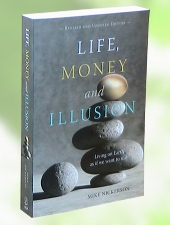The whole story:

Life, Money
and Illusion
Three Potent Steps to a Sane Economy
Amidst today's uncertainties, is an historic
opportunity to secure our lives and the lives of those
we love. First we have to recognize the common cause
of the financial and ecological crises - that human
activity is touching planetary limits.
In order to achieve a balanced relationship
with the Earth, we need to picture a new order in our
hearts and in our minds. Then, each time we buy food,
pump gas or have a conversation with a friend, we can
advance long-term well-being.
Two different types of economic activity are
identified below, followed by three potent steps we can
take toward a sane economy. Together they provide a
foundation for imagining what can be. As enough minds
ripen the images, change happens.
Please pass these details around.Share Tweet
Two types of economic activity:
"Economics" is a somewhat mysterious word
for "mutual provision." While, individually, we have
limited ability to provide for our needs, we produce
abundance in societies. Each person gets good at
certain tasks and we trade with each other.
There are two types of economic activity. One
type requires continual inputs of non-renewable
resources and produces problematic waste.
Transportation systems and disposable consumer
goods are examples. The other type consists largely of
human creativity and good-will, like education and
most health care at the preventative level. While there
are almost no physical limits to the amount of
education and preventative care that we can have,
there are serious limits associated with resource
intensive industries.
For the things that we do need from the resource
intensive line, the first two of the following steps
can reduce our impacts on the Earth dramatically.
All together, these three steps can usher in a long
period of ecological stability.
Three potent steps:
1) Shift the imagination and creativity that presently
goes into designing for obsolescence and use it,
instead, to design goods that are durable and easily
repaired.
2) Instead of using our persuasive communication
abilities to encourage people to throw things away
and to buy new stuff, we could use those same
talents to reclaim an appreciation for durable and
familiar products.
3) Finally, if we search for personal fulfillment in
what we can do with our lives, such as learning, love,
laughter, friendship, art, music, dance, sport, service,
and the like, rather than by accumulating and
consuming material goods, we could have more real
satisfaction while minimizing resource exploitation
and waste.
While such steps would do wonders for
securing the future, they would be disastrous for a
growth-based economy. We either have to increase
the size of the Earth, or reorganize mutual provision so
that we can all share in the necessary work and revel
in the new security.
There are many ways to reorganize mutual
provision to serve a mature (post growth) civilization,
but it is getting harder and harder to stretch the Earth.
Do we want to grow until we drop, or develop the
economics of sustainability? It is a Question of Direction.
More about the Question of Direction and how
we can cooperate to have the answer heard can be found
at: The Challenge and the Goal.
Civilizations don't change direction easily. They
must either suffer catastrophe, or exercise an
extraordinary redirection of will. By launching a
public discussion about which direction offers the better
future, millions will come to imagine the options.
Together we can then make a major contribution toward
redirecting society's will.
